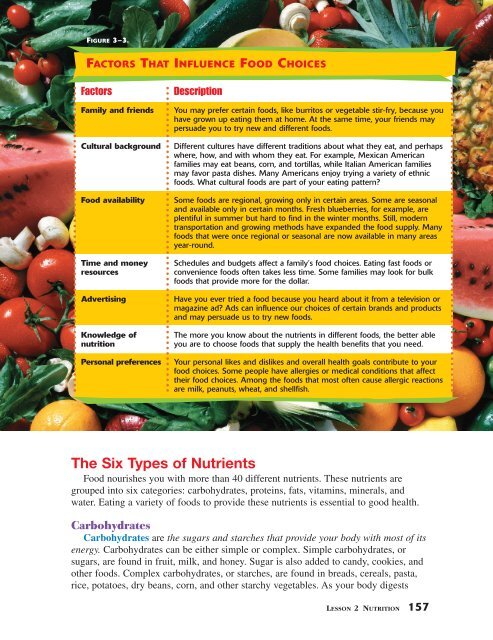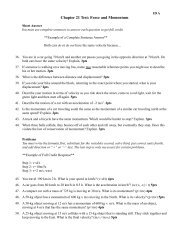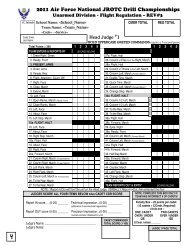AFJROTC Student Workbook CH03_Lesson_2 - Edgren High ...
AFJROTC Student Workbook CH03_Lesson_2 - Edgren High ...
AFJROTC Student Workbook CH03_Lesson_2 - Edgren High ...
You also want an ePaper? Increase the reach of your titles
YUMPU automatically turns print PDFs into web optimized ePapers that Google loves.
<strong>CH03</strong>_LE1 6/28/05 4:19 PM Page 157<br />
FIGURE 3–3.<br />
FACTORS THAT INFLUENCE FOOD CHOICES<br />
Factors<br />
Family and friends<br />
Cultural background<br />
Food availability<br />
Time and money<br />
resources<br />
Advertising<br />
Knowledge of<br />
nutrition<br />
Personal preferences<br />
Description<br />
You may prefer certain foods, like burritos or vegetable stir-fry, because you<br />
have grown up eating them at home. At the same time, your friends may<br />
persuade you to try new and different foods.<br />
Different cultures have different traditions about what they eat, and perhaps<br />
where, how, and with whom they eat. For example, Mexican American<br />
families may eat beans, corn, and tortillas, while Italian American families<br />
may favor pasta dishes. Many Americans enjoy trying a variety of ethnic<br />
foods. What cultural foods are part of your eating pattern<br />
Some foods are regional, growing only in certain areas. Some are seasonal<br />
and available only in certain months. Fresh blueberries, for example, are<br />
plentiful in summer but hard to find in the winter months. Still, modern<br />
transportation and growing methods have expanded the food supply. Many<br />
foods that were once regional or seasonal are now available in many areas<br />
year-round.<br />
Schedules and budgets affect a family’s food choices. Eating fast foods or<br />
convenience foods often takes less time. Some families may look for bulk<br />
foods that provide more for the dollar.<br />
Have you ever tried a food because you heard about it from a television or<br />
magazine ad Ads can influence our choices of certain brands and products<br />
and may persuade us to try new foods.<br />
The more you know about the nutrients in different foods, the better able<br />
you are to choose foods that supply the health benefits that you need.<br />
Your personal likes and dislikes and overall health goals contribute to your<br />
food choices. Some people have allergies or medical conditions that affect<br />
their food choices. Among the foods that most often cause allergic reactions<br />
are milk, peanuts, wheat, and shellfish.<br />
The Six Types of Nutrients<br />
Food nourishes you with more than 40 different nutrients. These nutrients are<br />
grouped into six categories: carbohydrates, proteins, fats, vitamins, minerals, and<br />
water. Eating a variety of foods to provide these nutrients is essential to good health.<br />
Carbohydrates<br />
Carbohydrates are the sugars and starches that provide your body with most of its<br />
energy. Carbohydrates can be either simple or complex. Simple carbohydrates, or<br />
sugars, are found in fruit, milk, and honey. Sugar is also added to candy, cookies, and<br />
other foods. Complex carbohydrates, or starches, are found in breads, cereals, pasta,<br />
rice, potatoes, dry beans, corn, and other starchy vegetables. As your body digests<br />
LESSON 2 NUTRITION 157














